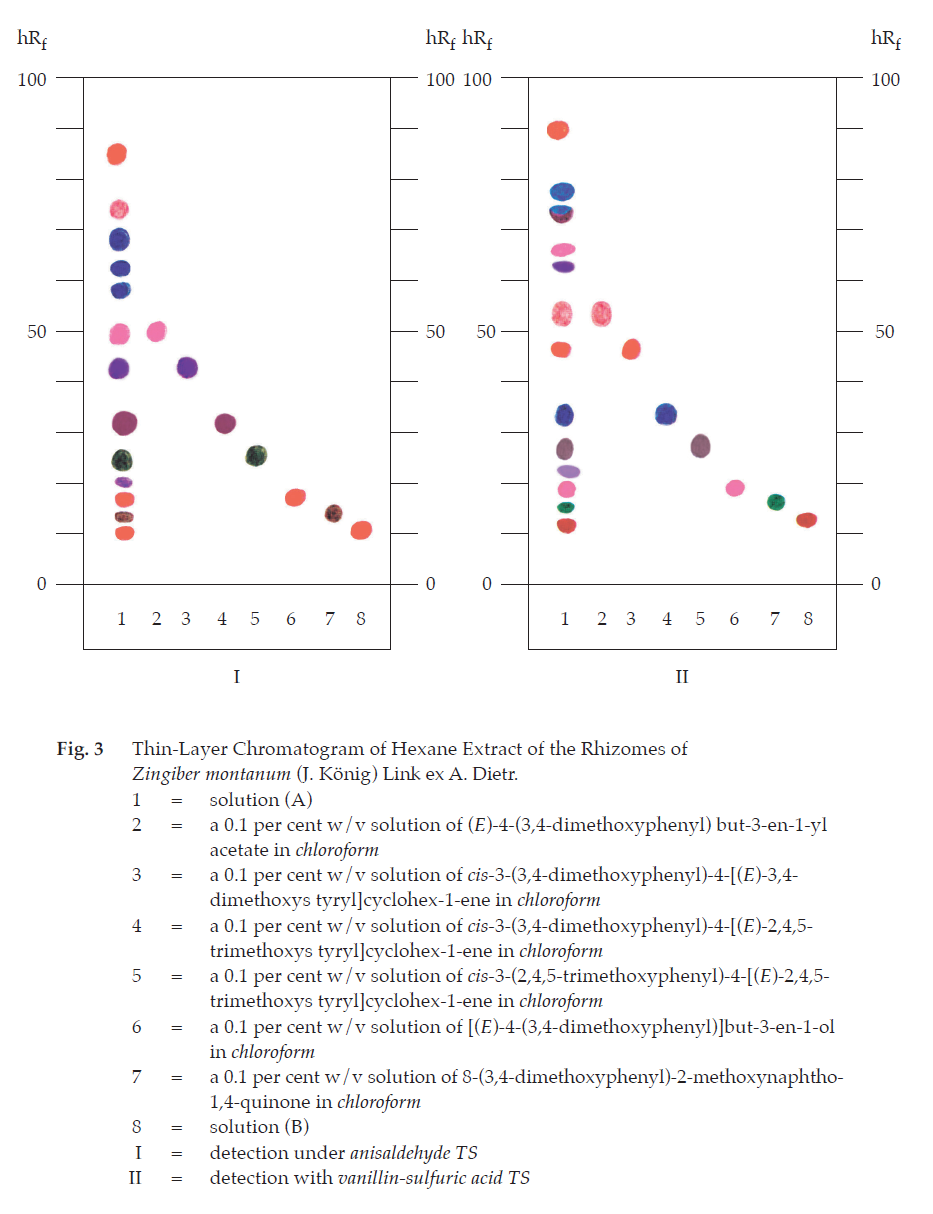ตำรามาตรฐานยาสมุนไพรไทย
Thai Herbal Pharmacopoeia
สำนักยาและวัตถุเสพติด กรมวิทยาศาสตร์การแพทย์ กระทรวงสาธารณสุข
Bureau of Drug and Narcotic, Department of Medical Sciences, Ministry of Public Health(Tinospora crispa (L.) Hook.f. & Thomson)
(Nelumbo nucifera Gaertn.)
(Centella asiatica (L.) Urb.)
(Centella Dry Extract)
(Centella Cream)
(Mesua ferrea L.)
(Piper sarmentosum Roxb.)
(Piper sarmentosum Roxb.)
(Pterocarpus santalinus L. f.)
(Santalum album L.)
(Senna tora (L.) Roxb.)
(Senna alata (L.) Roxb.)
(Senna Alata Tea)
(Piper retrofractum Vahl)
(Myristica fragrans Houtt)
(Andrographis paniculata (Burm. f.) Nees)
(Andrographis Capsules)
(Allium ascalonicum L.)
(Ocimum tenuiflorum L.)
(Curcuma longa L.)
(Turmeric Capsules)
(Turmeric Dry Extract)
(Turmeric Dry Extract Capsules)
(Arcangelisia flava (L.) Merr.)
(Curcuma sp.)
Harrisonia perforata (Blanco) Merr.
(Aristolochia pierrei Lecomte)
(Zingiber officinale Roscoe)
(Ginger Capsules)
(Ginger Tea)
(Cassia fistula L.)
(Nardostachys jatamansi (D. Don) DC.)
(Angelica sinensis (Oliv.) Diels)
Artemisia annua L.
(Ligusticum sinense Oliv. cv. Chuanxiong)
(Neopicrorhiza scrophulariiflora Pennell)
(Atractylodes lancea (Thunb.) DC.)
(Aucklandia lappa Decne)
(Terminalia chebula Retz.)
(Angelica dahurica (Hoffm.) Benth. & Hook. f. ex Franch. & Sav. var. dahurica)
(Kaempferia parviflora Wall. ex Baker)
(Hibiscus sabdariffa L.)
(Roselle Tea)
(Allium sativum L.)
(Zingiber zerumbet (L.) Sm.)
(Wurfbainia testacea (Ridl.) Škorničk.& A. D. Poulsen)
(Cannabis sativa L.)
(Myristica fragrans Houtt)
(Dracaena cochinchinensis (Lour.) S. C. Chen)
(Ficus racemosa L.)
(Hyptis suaveolens (L.) Poit.)
Clerodendrum indicum (L.) Kuntze
(Phyllanthus emblica L.)
(Citrus hystrix DC.)
(Citrus hystrix DC.)
(Areca catechu L.)
(Momordica charantia L.)
Moringa oleifera Lam.
(Aegle marmelos (L.) Corrêa)
(Solanum trilobatum L.)
(Morus alba L.)
Gynostemma pentaphyllum(Thunb.)
Makino
(Clinacanthus nutans (Burm. f.) Lindau)
(Cissus quadrangularis L.)
(Mimusops elengi L.)
(Zingiber montanum (J. König) Link. ex A. Dietr.)
(Piper betle L.)
(Capsicum annuum L.)
(Capsicum Oleoresin)
(Capsicum Gel)
(Piper nigrum L.)
(Piper nigrum L.)
(Eurycoma longifolia Jack)
(Thunbergia laurifolia Lindl.)
(Piper wallichii (Miq.) Hand.-Mazz.)
Senna garrettiana (Craib) H. S. Irwin & Barneby
(Terminalia bellirica (Gaertn.) Roxb.)
(Terminalia chebula Retz.)
(Caesalpinia bonduc (L.) H. Roxb.)
(Tarlmounia elliptica (DC.) H. Rob., S. C. Keeley, Skvaria & R. Chan)
(Hog Creeper Vine Dry Extract Capsiles)
(Hog Creeper Vine Dry Extract)
(Brachypterum scandens (Roxb.) Miq.)
(Lepidium sativum L.)
(Nigella sativa L.)
(Cuminum cyminum L.)
(Foeniculum vulgare Mill.)
(Plantago ovata Forssk.)
(Pimpinella anisum L.)
(Carum carvi L.)
(Anethum graveolens L.)
(Trachyspermum ammi (L.) Sprague)
Albizia procera (Roxb.) Benth.
(Acorus calamus L.)
(Tiliacora triandra (Colebr.) Diels)
Cyanthillium cinereum (L.) H. Rob.
(Orthosiphon aristatus (Blume) Miq.)
Murdannia loriformis (Hassk.) R. S. Rao & Kammathy
(Capparis micracantha DC.)
(Chrysopogon zizanioides (L.) Roberty)
(Cyperus rotundus L.)
(Cannabis sativa L.)
(Syzygium aromaticum (L.) Merr. & L. M. Perry)
(Boesenbergia rotunda (L.) Mansf.)
(Acanthus ebracteatus Vahl)
(Acanthus ilicifolius L.)
(Kaempferia galanga L.)
(Curcuma comosa Roxb.)
Betula alnoides Buch.-Ham. ex D. Don
Cannabis sativa L.
Carthamus tinctorius L
Mitragyna speciosa (Korth.) Havil
Mallotus repandus (Rottler) Müll. Arg
Azadirachta indica A. Juss. var. siamensis Valeton
Azadirachta indica A. Juss. var. siamensis Valeton
Punica granatum L.
Rhinacanthus nasutus (L.) Kurz
Baliospermum solanifolium (Burm.) Suresh
Curcuma aeruginosa Roxb
Boesenbergia kingii Mood & L. M. Prince
Senegalia rugata (Lam.) Britton & Rose
Acacia concinna (Willd.) DC.
Senegalia rugata (Lam.) Britton & Rose
Acacia concinna (Willd.) DC.
Senna alexandriana Mill. var. alexandriana
Cassia acutifolia Delile, Cassia angustifolia Vahl
Butea superba Roxb. ex Willd.
[Plaso superba (Roxb. ex Willd.) Kuntze, Rudolphia superba (Roxb. ex Willd.) Poir.
Pueraria candollei Graham
ex Benth. var. mirifica (Airy Shaw & Suvat.) Niyomdham
Streblus asper Lour.
Suregada multiflora (A. Juss.) Baill. (Gelonium
multiflorum A. Juss.
Zingiber Montanum Rhizome is the dried rhizome of Zingiber montanum (J. König) Link ex A. Dietr. (Z. cassumunar Roxb.) (Family Zingiberaceae), Herbarium Specimen Number: DMSC 900, Crude Drug Number: DMSc 0308.
(Note It should be harvested after three-year cultivation.)
Constituents Zingiber Montanum Rhizome contains cyclohexene derivatives, viz., cis-3-(3,4-dimethoxyphenyl)-4-[(E)-3,4-dimethoxystyryl]cyclohex -1-ene, cis-3-(2,4,5-trimethoxyphenyl)-4-[(E)-2,4,5-trimethoxystyryl]cyclohex-1-ene and cis-3-(3,4dimethoxyphenyl)-4-[(E)-2,4,5 trimethoxystyryl]cyclohex-1-ene; naphthoquinone derivatives, viz., 8-(3,4- dimethoxyphenyl)-2-methoxynaphtho-1,4-quinone; phenylbutanoids, viz., (E)-4-(3,4- dimethoxyphenyl)but-3-en-1-yl acetate and [(E)-4-(3,4-dimethoxyphenyl)]but-3-en-1-ol; vanillin; vanillic acid; veratric acid; curcumin; β-sitosterol; volatile oil consisting of α-pinene, β-pinene, sabinene, myrcene, α-terpinene, limonene, γ-terpinene, p-cymene, terpinolene, and terpinen-4-ol.
Description of the plant (Figs. 1a, 1b) Herb, rhizome fleshy thick, greenish yellow to yellow inside, horizontal with many sessile tubers. Leafy stem 1 to 1.5 m tall. Leaves distichous, oblong-lanceolate, 20 to 30 cm long, 2 to 8 cm wide, pubescent below; ligule very short, bilobed, pubescent; sheath glabrous or hairy. Inflorescence scapose; peduncle 8 to 30 cm long, clothed with pubescent sheaths. Spike ovoid-ellipsoid; bract greenish red, narrowly obovate or rhomboid, 2.5 to 3.5 cm long; bracteole shorter than bract, ovate, 3-dentate. Calyx truncate, glabrous. Corolla pale yellow, tube about 2.5 cm long, dorsal lobe cymbiform, lateral lobe linear-lanceolate. Labellum pale yellow, suborbicular, apex emarginate, lateral lobe ovate-oblong, appendage slightly longer than anther; stamen pale yellow; ovary 3-celled, inferior. Fruit, small globose capsule.
Description Odour, pleasantly aromatic; taste, pungent.
Macroscopical (Fig. 1a) Transverse slices, 2 to 5 mm thick, greenish yellow with light brown skin; fracture fibrous, mealy; surface shows a narrow cortex separated by endodermis from a much wider stele.
Microscopical (Figs. 2a, 2b) Transverse section of the rhizome shows epidermis, outer cortex, cork, inner cortex, endodermis, stele, and fibrovascular bundle. Epidermis, a layer of rectangular cells. Outer cortex, parenchyma cells. Cork, several layers of thin-walled, rectangular cells. Inner cortex, thin-walled parenchyma cells containing numerous starch granules and oleoresin; starch granules mostly simple, 30 to 75 μm long, 20 to 40 μm wide, accompanied with 2- to 6-compound grains, oblong to oval in outline with a small hilum at narrow end, very faint eccentric striations. Endodermis, a layer of thin-walled cells. Stele, thin-walled parenchyma cells containing starch granules and oleoresin. Fibrovascular bundle, not yielding the reaction characteristic of lignin, scattered in inner cortex and stele; vessels, mostly scalariform and reticulate, spiral and annular.
Zingiber Montanum Rhizome in powder possesses the diagnostic microscopical characters of the unground drug.

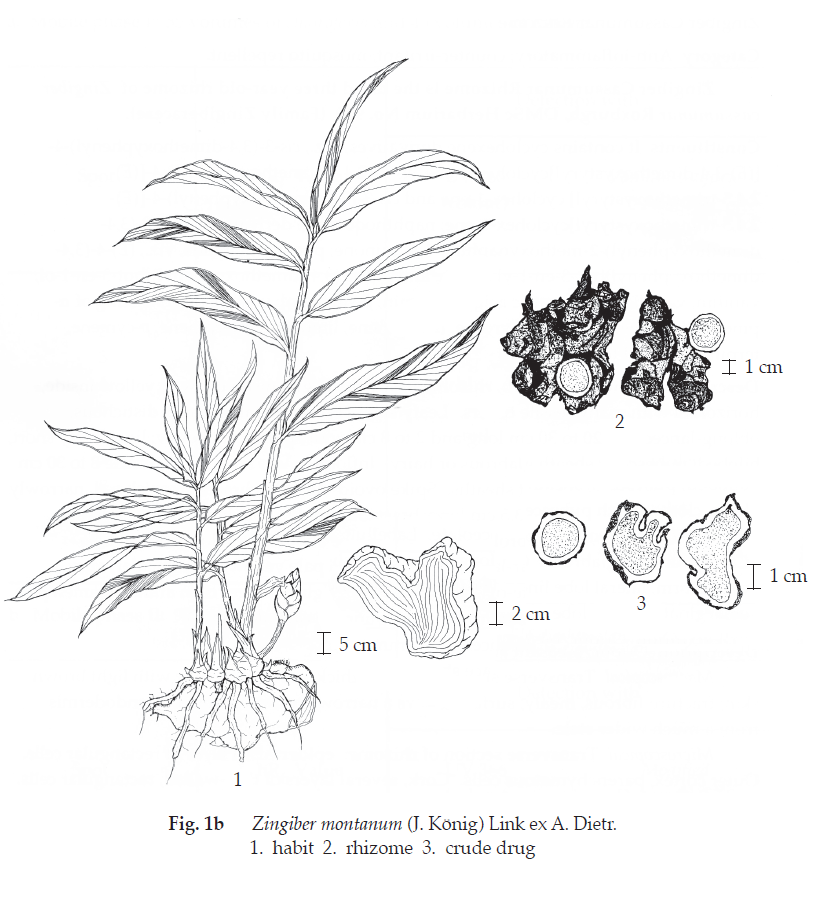
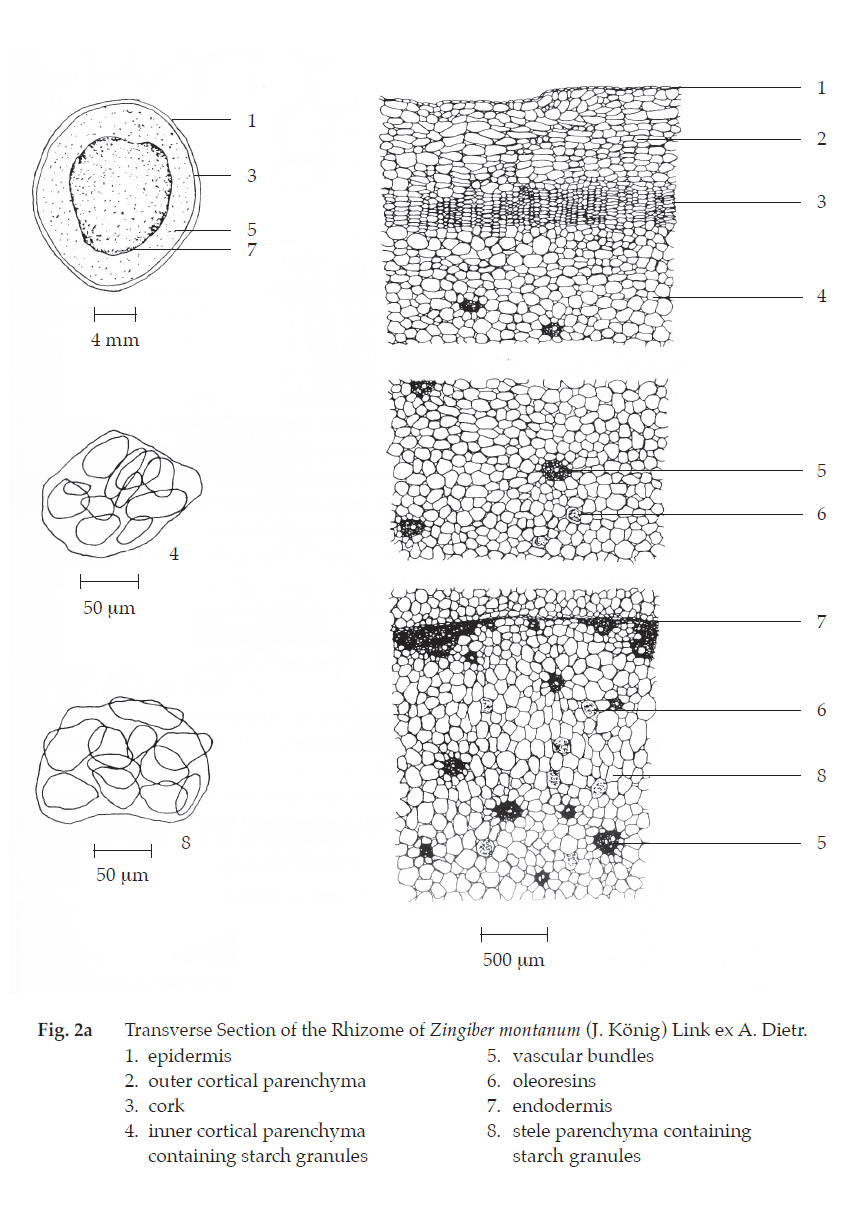
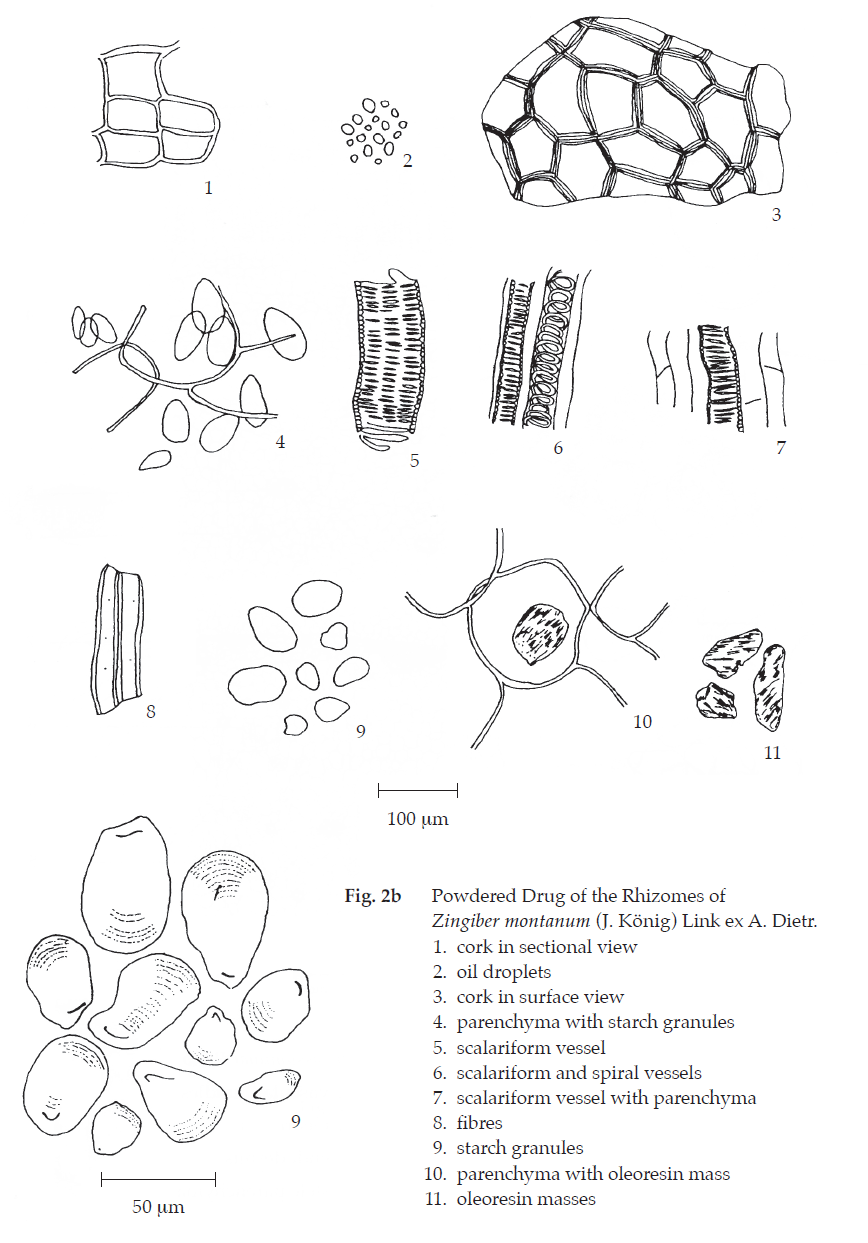
Packaging and storage Zingiber Montanum Rhizome shall be kept in well-closed containers, preferably of metal or glass, protected from light and stored in a cool and dry place.
Identification
A. To 500 mg of the sample, in powder, add 5 mL of chloroform, set aside for 5 minutes and filter (solution 1). Examine 1 mL of solution 1 under ultraviolet light (366 nm): a greenish yellow fluorescence is observed.
B. To 1 mL of solution 1, add 0.2 mL of acetic anhydride-sulfuric acid TS: a reddish brown colour is produced.
C. To 1 mL of solution 1, add 1 mL of boric acid-methanol TS: an orange colour is produced.
D. Carry out the test as described in the “Thin-Layer Chromatography” (Appendix 3.1), using silica gel GF254 as the coating substance and a mixture of 70 volumes of hexane and 30 volumes of ethyl acetate as the mobile phase. Apply separately to the plate, 2 μL of solution (A) and 3 μL of solution (B). Prepare solution (A) by extracting 2.5 g of the sample, in powder, with three 10-mL portions of hexane. Evaporate the hexane extract to dryness and dissolve the residue in 5 mL of chloroform. For solution (B) dissolve 1 mg of curcumin in 1 mL of chloroform. After removal of the plate, allow it to dry in air and examine under ultraviolet light (254 nm), marking the quenching spots. The spots obtained with solution (A) correspond in hRf values to the spot numbers 2, 3, 5, 6, 7, and 8. Several spots of higher hRf values are also observed (Table 1); see also Fig. 3. Spray the plate with anisaldehyde TS and heat at 110° for 10 to 15 minutes; the spots due to those of numbers 2, 3, 5, 6, 7, and 8 in Table 1 are brown, carmine-red, olive-green, wine-red, violet, and dark pink, respectively. A red spot due to curcumin (hRf values 10 to 13) and other spots of different colours are observed (Table 1); see also Fig. 3.
Repeat the same procedure on another plate but spray with vanillin-sulfuric acid TS and heat at 110° for 10 to 15 minutes; the spots due to those of numbers 2, 3, 5, 6, 7, and 8 are olive-green, dark pink, purple, blue-violet, red, and pale orange, respectively. A red-brown spot due to curcumin (hRf values 10 to 13) and other spots of different colours are observed (Table 1); see also Fig. 3.
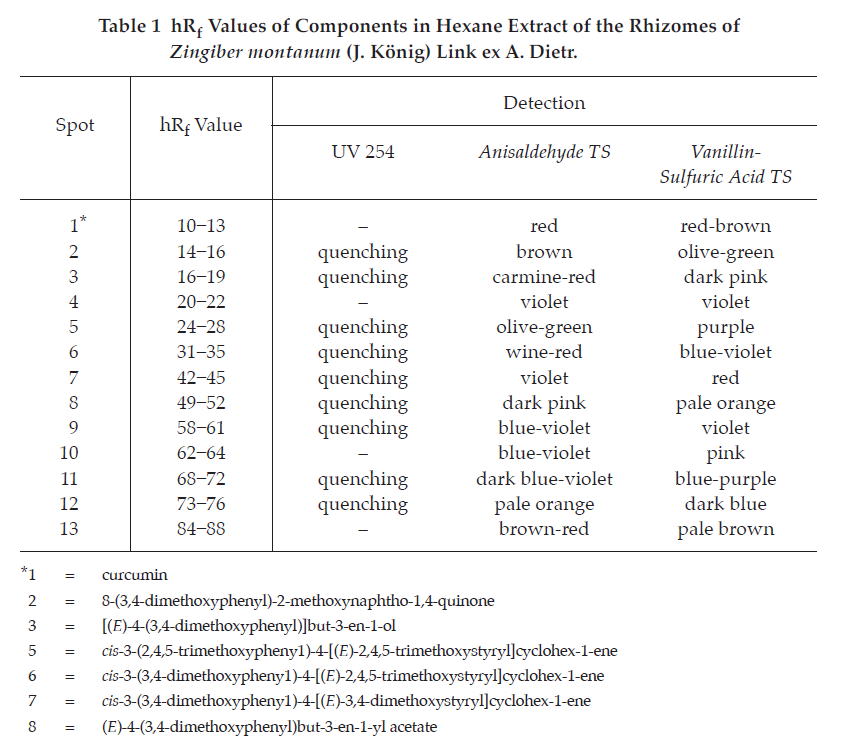
Water Not more than 13.0 per cent w/w (Azeotropic Distillation Method, Appendix 4.12).
Foreign matter Not more than 2.0 per cent w/w (Appendix 7.2).
Acid-insoluble ash Not more than 3.0 per cent w/w (Appendix 7.6).
Total ash Not more than 9.0 per cent w/w (Appendix 7.7).
Hexane-soluble extractive Not less than 3.0 per cent w/w (Appendix 7.12H).
Chloroform-soluble extractive Not less than 5.0 per cent w/w (Appendix 7.12H).
Volatile oil Not less than 2.0 per cent v/w (Appendix 7.3H). Use 10 g, in coarse powder, freshly prepared and accurately weighed. Use 100 mL of water as the distillation liquid and a 500-mL round-bottomed flask. Distil at a rate of 2 to 3 mL per minute for 5 hours. Use 2.0 mL of xylene in the graduated tube.
